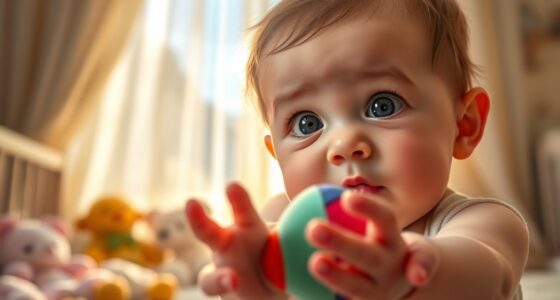When you play peekaboo, your baby’s brain begins to grasp object permanence — understanding that hidden objects still exist. This vital milestone develops between 4-12 months as their senses and memory improve, helping them connect what they see, feel, and anticipate. As they experiment with finding hidden items, they’re building trust and confidence in exploring their world. Keep engaging with these playful interactions, and you’ll discover how their understanding continues to grow.
Key Takeaways
- Peekaboo demonstrates how infants develop object permanence by revealing that hidden objects still exist.
- Playing peekaboo enhances memory, anticipation, and understanding of object permanence in babies aged 8-12 months.
- Responsive interactions like peekaboo support cognitive growth by linking visual cues with mental representations of hidden objects.
- Recognizing object permanence through peekaboo helps build infants’ confidence in exploring their environment safely.
- The game aligns with critical developmental stages, reinforcing neural connections involved in sensory integration and cognitive skills.

Understanding object permanence is essential to grasp how infants develop a sense of the world around them. This concept marks a significant cognitive milestone, indicating that your baby begins to understand that objects continue to exist even when they’re out of sight. As your little one’s brain develops, their sensor development plays a pivotal role in how they process and interpret their environment. During this phase, your infant’s senses become more refined, allowing them to explore and make sense of the world, which sets the foundation for understanding object permanence.
Understanding object permanence helps infants explore and understand their world as their senses develop.
In the early months, your baby’s sensor development is primarily focused on their senses of sight, touch, and hearing. Their ability to visually track moving objects improves, and they start to recognize familiar faces and objects from different angles. This progress is an essential step toward grasping that objects still exist even when they aren’t directly in front of them. As their cognitive milestones unfold, they begin to anticipate the return of objects they’ve seen disappear, although their understanding is still limited at this stage.
By around 4 to 8 months, your infant’s cognitive milestones include increased curiosity and intentional exploration. They might look for a toy that’s been hidden or peek behind a cloth to find a familiar face. During this period, their sensor development enables them to connect visual cues with their actions. For example, if you hide a toy under a cloth, they might reach for it, demonstrating that they’re starting to understand the concept of object permanence. However, their understanding isn’t fully developed yet—they may still be surprised when an object they’ve seen disappear doesn’t reappear immediately.
As your baby approaches 8 to 12 months, their sensor development and cognitive milestones converge further. Their ability to remember and anticipate increases, and they begin to understand that objects exist even out of sight. This is the peekaboo principle in action—the simple game that reveals so much about their cognitive growth. When you hide your face or an object and then reveal it again, your baby is actively learning that the hidden thing still exists. This stage marks a significant leap in their brain’s ability to link sensory information, memory, and understanding, all of which are essential components of developing a complete sense of the world.
Throughout this process, your baby’s sensor development and cognitive milestones work together to build the foundation for more complex thought processes. Recognizing that an object continues to exist when out of sight isn’t just about curiosity; it’s a core part of how your child begins to understand and navigate their environment confidently. Additionally, research shows that critical periods for skill acquisition are crucial to this developmental stage, emphasizing the importance of engaging and responsive interactions during this time.
Frequently Asked Questions
When Do Babies Typically Develop Object Permanence?
You might wonder when babies develop object permanence. Typically, around 8 to 12 months, your little one’s visual development improves, helping them understand that objects still exist even when out of sight. This milestone also ties into language development, as they begin to associate words with objects. During this time, your baby starts to search for hidden items, showing they’re grasping the concept of object permanence.
How Can I Encourage My Baby’s Understanding of Object Permanence?
To encourage your baby’s understanding of object permanence, engage in activities like visual tracking and sensory play. For example, hide a toy partially and encourage your baby to find it, helping them understand objects still exist when out of sight. Use colorful objects and gentle movements to capture their attention, and always praise their efforts. These simple, fun interactions boost their cognitive development and reinforce the concept of object permanence.
Does Object Permanence Development Vary Across Different Cultures?
You might wonder if cultural differences and parenting practices influence how your baby develops object permanence. Research suggests that cultural norms and caregiving styles can impact the timing and ways babies grasp object permanence. In some cultures, more interactive play or different routines may accelerate understanding, while others may follow distinct approaches. Recognizing these variations helps you support your baby’s development in a way that aligns with your cultural context.
Are There Signs of Delayed Object Permanence in Infants?
You might wonder if there are signs of delayed object permanence in infants. Typically, children reach object permanence milestones around 8-12 months, but developmental delays can occur. If your baby doesn’t show signs of understanding that objects continue to exist when out of sight by this age, it could indicate a delay. Monitoring their progress and consulting a pediatrician can help assess if further evaluation or intervention is needed.
How Does Object Permanence Influence a Baby’S Emotional Development?
Object permanence plays a key role in your baby’s emotional development. As they understand that objects and people still exist even when out of sight, they build emotional attachment and trust. This understanding helps your baby feel secure, knowing you’ll come back after leaving the room or hiding toys. When they develop object permanence, their confidence grows, strengthening their ability to form healthy relationships and trust in you and the world around them.
Conclusion
So, when your baby finally masters object permanence, it’s like they’ve revealed the secret code to the universe! Suddenly, the world isn’t just a fleeting shadow—they hold the entire cosmos in their tiny hands. This tiny breakthrough sparks a brain explosion, turning your little one into a super detective who can find hidden treasures and solve mysteries faster than you can say “peekaboo.” It’s truly the moment your baby’s brain goes from a flickering candle to a blazing supernova!










